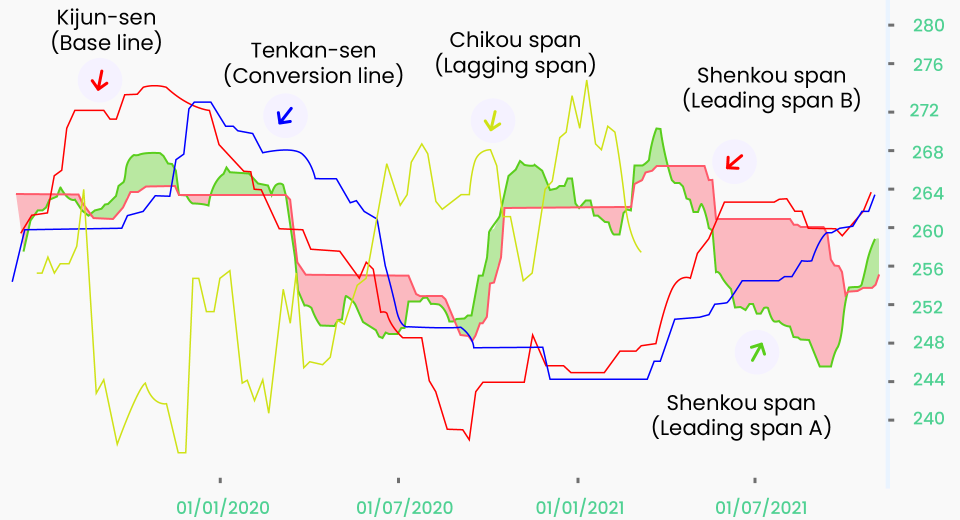The Fibonacci sequence is found everywhere in nature, from spirals of galaxies to branches of a tree and from DNA molecules to hurricanes. Financial analysts, who believed that market movements demonstrate phenomena similar to nature, pioneered using Fibonacci ratios to identify and predict asset price trends. Read on to learn all about using Fibonacci levels for trading.
What are Fibonacci Levels?
The Fibonacci sequence is a number sequence with every number being the sum of the previous two, starting from 0 and 1 as the first two numbers. So, the sequence is:
0, 1, 1, 2, 3, 5, 8, 13, 21, 34, 55…
Fibonacci Constant
Also known as the Golden Ratio, 0.618 is the ratio of any two consecutive numbers on the Fibonacci sequence. This means that each number is approximately 1.618 times larger than the previous one:
1/1=1
2/1=2
3/2=1.5
5/3=1.666…
8/5=16
13/8=1.625
21/13=1.61538
34/21=1.619
55/34=1.6176
… And so on
On skipping a number in the sequence and calculating ratios, you get two more constants: 0.382 and 2.618.
3/1=3
5/2=2.5
8/3 = 2.66…
13/5=2.6
21/8=2.625
34/13 =2.615
55/21 =2.619
Continuing the process generates more such constants.
Fibonacci Levels
Traders use these ratio constants as Fibonacci levels. The most popularly used retracement levels in trading are 23.6%, 38.2%, 50% and 61.8%. Although 50% is not strictly a Fibonacci ratio, it is a commonly used level. The most popularly used key extension levels are 61.8%, 100%, 161.8%.
Fibonacci Analysis
Traders use Fibonacci ratios to mark the level to which an asset’s price might retrace after a pullback or the price point to which it may rally after a breakout. A useful feature of the Fibonacci indicator is that it can be used for any timeframe. Therefore, it can be used by scalpers, intra-day traders, swing traders and those using long-term strategies.
Traders start by selecting two price points around the current price point. The lower level is 0 (0%) and the higher is 1 (100%). These two levels are called the anchor points. Then, using a Fibonacci charting tool, horizontal lines representing the Fibonacci percentages are drawn. Commonly, traders pair Bollinger Bands, Moving Averages or any other indicator to identify whether they should be using retracement or extension levels. This means they speculate whether the market is going to reverse or continue on its trajectory to decide whether they should use these levels as entry or exit points.
A common challenge that traders face is identifying the anchor points. Traders use other indicators to identify the 0% and 100% of the Fibonacci indicator. Then, they apply the Fibonacci indicator to generate the retracement and extension levels.
Trading Fibonacci Retracement
Retracement levels are used when the price begins a new trend in any direction. The price may either retrace or return to the previous trend or a previous level, at any of these levels. Retracement levels are plotted within the anchor price points.
Traders open long positions when the price is trending upwards, and the Fibonacci retracement becomes the support level.
Traders open short positions when the market is bearish, and the Fibonacci retracement level serves as the resistance level.
The Fibonacci indicator does not predict whether the price will bounce back or not. It only signals the possible levels. Whether it will bounce or not can be predicted using other indicators and market updates.
Trading Fibonacci Extensions
Experts in the industry believe that knowing when to get out is as critical as knowing when to get in. The extension levels are marked beyond the anchor points. Fibonacci extension levels are the ones where a trader takes profits and exits the position. Whether one should exit or not can be determined by using other indicators that help identify the strength and volume during a trend.
During an uptrend, traders set take profit levels to exit long positions at the extension levels. These levels become levels of resistance.
Since the market finds support at Fibonacci extension levels during a downtrend, traders usually choose to exit short positions at these levels.
Mistakes to Avoid When Using the Fibonacci Indicator
- Holding on to a level as support or resistance. Instead, determine the actual move the price might make by considering market direction, the strength of a trend, sentiment and volatility. Then use the Fibonacci levels.
- Not resetting the anchor points for Fibonacci levels from time to time. Since Fibonacci levels are static, it is essential to reset these levels once the price has moved beyond the possibility of retracing back to or extending to those previous percentages.
- Believing that the Fibonacci sequence is infinite and that continuing the process can ultimately help find the exact level of retracement or extension. Experienced traders use their discretion to determine the number of levels they want to use for each instrument.
- Trying to force Fibonacci levels on the market. This only leads to disappointment. Experts learn to accept the way the market moves rather than trying to forcibly identify the reason why a certain Fibonacci level failed to become the support or resistance level.
- Not practicing on a demo account. This means the strategy has not been tested and refined. Before entering the market, it is useful to practice applying the Fibonacci indicator, while using other indicators as confirmation, and assessing their risk potential before making trading decisions.
To Sum Up
- The Fibonacci indicator has been developed from the famous Fibonacci sequence.
- Ratios of the Fibonacci sequence are used to generate Fibonacci retracement and extension levels on price charts.
- Fibonacci levels can be used for short-term, medium-term and long-term trading strategies.
- Beginner traders must remember that Fibonacci levels are only areas of interest, since the price could bounce off these levels.
- Retracement levels are used as entry points or levels of price pullback.
- Extension levels are used to determine how far an asset’s price could move in any direction to identify take-profit levels.
- Experienced traders determine the possibility of reversal or breakout using additional indicators.
Disclaimer:
All data, information and materials are published and provided “as is” solely for informational purposes only, and is not intended nor should be considered, in any way, as investment advice, recommendations, and/or suggestions for performing any actions with financial instruments. The information and opinions presented do not take into account any particular individual’s investment objectives, financial situation or needs, and hence does not constitute as an advice or a recommendation with respect to any investment product. All investors should seek advice from certified financial advisors based on their unique situation before making any investment decisions in accordance to their personal risk appetite. Blackwell Global endeavours to ensure that the information provided is complete and correct, but make no representation as to the actuality, accuracy or completeness of the information. Information, data and opinions may change without notice and Blackwell Global is not obliged to update on the changes. The opinions and views expressed are solely those of the authors and analysts and do not necessarily represent that of Blackwell Global or its management, shareholders, and affiliates. Any projections or views of the market provided may not prove to be accurate. Past performance is not necessarily an indicative of future performance. Blackwell Global assumes no liability for any loss arising directly or indirectly from use of or reliance on such information herein contained. Reproduction of this information, in whole or in part, is not permitted.





